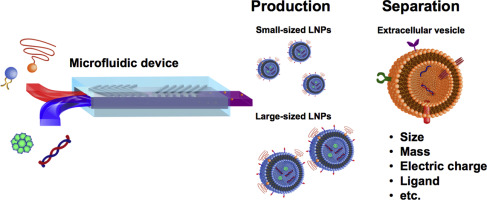Advanced Drug Delivery Reviews ( IF 15.2 ) Pub Date : 2018-03-19 , DOI: 10.1016/j.addr.2018.03.008 Masatoshi Maeki , Niko Kimura , Yusuke Sato , Hideyoshi Harashima , Manabu Tokeshi

|
Lipid-based nanobiomaterials as liposomes and lipid nanoparticles (LNPs) are the most widely used nanocarriers for drug delivery systems (DDSs). Extracellular vesicles (EVs) and exosomes are also expected to be applied as DDS nanocarriers. The performance of nanomedicines relies on their components such as lipids, targeting ligands, encapsulated DNA, encapsulated RNA, and drugs. Recently, the importance of the nanocarrier sizes smaller than 100 nm is attracting attention as a means to improve nanomedicine performance. Microfluidics and lab-on-a chip technologies make it possible to produce size-controlled LNPs by a simple continuous flow process and to separate EVs from blood samples by using a surface marker, ligand, or electric charge or by making a mass or particle size discrimination. Here, we overview recent advances in microfluidic devices and techniques for liposomes, LNPs, and EVs and their applications for DDSs.
中文翻译:

脂质纳米颗粒和细胞外囊泡微流控技术的进展及其在药物输送系统中的应用
作为脂质体和脂质纳米颗粒(LNP)的基于脂质的纳米生物材料是用于药物输送系统(DDS)的最广泛使用的纳米载体。细胞外囊泡(EVs)和外泌体也有望用作DDS纳米载体。纳米药物的性能取决于它们的成分,例如脂质,靶向配体,包裹的DNA,包裹的RNA和药物。近来,小于100nm的纳米载体尺寸的重要性作为改善纳米药物性能的手段而引起关注。微流体技术和芯片实验室技术使得可以通过简单的连续流动过程生产尺寸受控的LNP,并可以通过使用表面标记,配体或电荷或通过确定质量或粒径来将EV与血液样品分离歧视。这里,











































 京公网安备 11010802027423号
京公网安备 11010802027423号